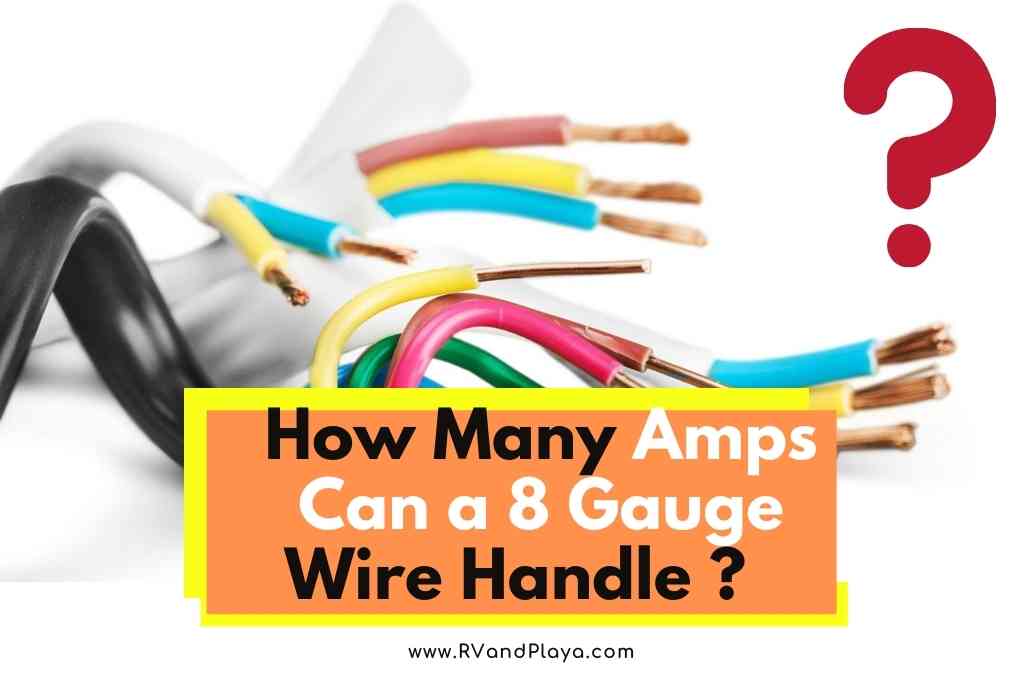Do you know how many amps a 8 gauge wire can handle? this is one of the questions our readers ask a lot. Well, we´ve got you covered.
When you get into the category of size 8 wiring, you’re getting more and more into what you would consider being residential applications.
Although residential circuits are generally 15 and 20 amps, there are several applications for 8-gauge wiring in the home.
So, how many amps can a 8 gauge wire handle? Like all of the other wire sizes, 8-gauge comes in two types (three if you consider copper-clad aluminum to be an option) and when it comes to copper wires, a size 8 can handle between 40 and 55 amps, while the aluminum counterpart can handle between 30 and 45 amps.
However, just because size 8 copper can handle 55 amps and aluminum can handle 45 amps doesn’t necessarily mean that they should.
There are a host of factors that goes into what each wire will handle, why, and under what constraints.
For instance, size 8 aluminum wire can handle 45 amps but only when there is a temperature rating that exceeds the minimum, in which case the size 8 wire will have an XHHW-2, THHN, or THWN-2 insulation.
Table of Contents
Different Amps for Different Situations
Temperature ratings are the most common factors when it comes to the choice of 8-gauge wiring, because the use that you put it through is going to determine how warm the wire gets and, as a result, the kind of insulation it will be jacketed in.
For instance, if you are using size 8 NM-B or UF-B wire, you can’t run any more than 40 amps and even if you were running 40 amps through it, it probably wouldn’t be considered to be the safest thing in the world.
That’s because, at 40 amps, the 8-gauge wire will heat up to 140°F, which is the maximum temperature that it can get to before the insulation jacketing becomes compromised.
You don’t want that insulation to melt off, exposing the size 8 wire. Then it becomes a serious health hazard.
It’s not the voltage that kills people, it’s amps and it doesn’t even take a full amp to put you into cardiac arrest.
| Temp | 60°C (140°F) NM-B UF-B | 75°C (167°F) THW THWN SE USE XHHW | 90°C (194°F) THWN-2 THHN XHHW-2 |
|---|---|---|---|
| Size 8 Copper | 40 amps | 50 amps | 55 amps |
| Size 8 Aluminum | N/A | 40 amps | 45 amps |
As you can see on the above table, there are limitations to the current that a size 8 wire can handle, depending on the type of wiring that you choose.
A size 8, copper wire using THWN-2 is more than capable of handling 50A or 40A because it won’t heat up enough to create a potentially dangerous hazard.
However, just because it says that a THHN Size 8 wire can handle 55A doesn’t mean that you should. There are plenty of variations of the saying that discusses “playing with fire” and maxing out the amps that a given conductor should handle is a recipe that’s just asking for it.
The little “all-caps” acronyms that are associated with the copper or aluminum wire that you are purchasing are actually letters that refer to what the insulation can handle.
For example, THHN stands for Thermoplastic, High-Heat Resistant, and Nylon-Covered.
It simply gives you an exact understanding of what you are working with and is almost entirely responsible for the decision on whether to run 40 amps through a conductor or 50 amps through a conductor.
Difference Between Copper and Aluminum
Once upon a time, the US tried using silver as the primary conductor throughout the power lines in certain areas of the country, until it was decided that although silver is a phenomenal conductor, it was just too expensive to continue using it.
That was when many switched over to aluminum. Copper was a major part of it as well but aluminum played a huge role.
It’s not as good as copper at conducting electricity but it is very lightweight and, even more importantly back then, more affordable.
That’s still true today, even though the affordability of aluminum over copper and copper-clad alternatives is no longer the largest of the deciding factors. When ot comes to 8-gauge wiring, copper is by far the more prevalent form that’s used in commercial, industrial, and residential applications.
Since aluminum is more resistant to heat, there is no aluminum wiring in the 60°C category, with NM-B and UF-B insulating properties.
It is used only with the two higher temperature ratings and that includes copper-clad aluminum.
Read also: How Many Amps Can a 10 Gauge Wire Handle (220 Volts)
What is Size 8 Wire Used For?
Size 8 wire has far more applications and usefulness within residential and commercial applications that the three larger variations, 6, 4, and 2 gauge wire.
Its a little more in line with the requirements of major appliances, whereas 6-gauge is a bit of overkill.
Although most homes are rated for 15 and 20 amps, and the vast majority of wiring found inside of homes will be 12 and 14-gauge, there are still several applications for 8-gauge wire.
- Washers and Dryers
- Dishwashers
- Hot Water Heaters
- HVAC units
- Large dehumidifiers
In standard terms, you will see 8-gauge wire, in residential applications, when there is some fear that voltage drop or loss would be a factor.
You can easily and safely hook size 8 wire to a 20A circuit. The wire is more than capable of handling it and will do so with less resistance than typical household conductors.
However, 8-gauge wire typically won’t fit in receptacles as the screws, especially behind light switches and power outlets, will only allow something as large as a size 10 wire to fit.
You will see 8-gauge wire often in appliances and they are generally run to 30A or 20A circuits, depending on the amp requirements of the appliance.
For example, your typical dishwasher will run at around 10 amps, however, your circuits should always be rated well above your appliance requirements.
Thanks to the understanding of voltage loss and drop, especially in a complex electrical wiring environment, it makes sense to go with a much larger gauge when dealing with major appliances.
You will also find 8-gauge wire in your HVAC system, especially on the outside unit; refrigerators as well.
One thing that refrigerators and AC units have in common is the surge power required when they kick on their cooling capabilities.
That brief surge in power requirements far exceeds what either one of the two appliances needs under normal operating procedures.
But they do require something a little larger to accommodate the surge when the compressors or condensers kick on.
You will find 8-gauge wiring in many applications commercially. Oftentimes, large grocery chains or big store retailers use 6 and 8-gauge wiring to power their lighting infrastructure.
You will also find that it is frequently used in large scale appliances and machinery.
In fact, 8-gauge wiring is far more prevalent than 6-gauge, when it comes to most appliances in commercial and industrial applications.
All Things Considered
Size 8 wire can handle anywhere between 40 and 55 amps and the aluminum versions can handle 40 to 45 amps. This type of wiring has a lot of applications both in commercial and residential buildings.
Depending on the temperature ratings of the wire, size 8 wire can handle quite a bit of current before it reaches a point where it is too hot for the insulation and jacket that gives it higher parameters.
Here are some of my favorite tools & equipment´s
Thank you for reading this article. I hope it helps you find the most recent and accurate technical and repair information for your car. Here are some tools that I use as an automotive technician and hope you´ll also find helpful.
There are affiliate links, so if you do decide to use any of them, I´ll earn a small commission. But in all honesty, these are the exact tools that I use and recommend to everyone, even my own family. (NO CRAP)
To see all my of most up-to-date recommendations, check out this resource that I made for you!
References
https://www.cityelectricsupply.com/downloads/Ampacity%20Chart.pdf
https://www.achrnews.com/articles/135676-what-most-techs-get-wrong-about-wire-sizing
Recent Posts
Have you ever asked yourself or your friend how many Amps a 4 gauge wire can handle? Well, you are at the perfect place to find the answer to such a question. You don’t have to be an electrician...
How Many Amps Can a 16 Gauge Wire Handle? (120 Volts, 12 Volts)
For general purposes, 16 gauge wire is found in extension cords and used in all the ways extension cords are normally used, such as leaf blowers, hedge trimmers, or connecting appliances across the...


